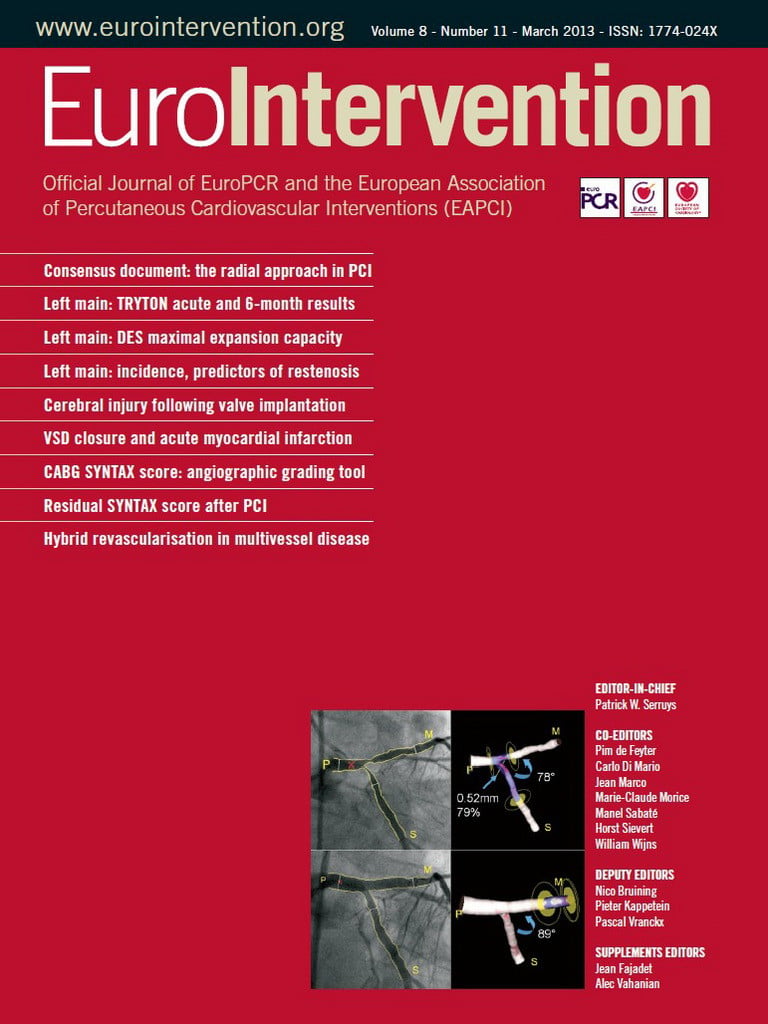A consensus document is important for our community. It represents the desire of our association to bring together leading specialists on an issue or a technique to reflect on its proper use and deployment based on current evidence and practice. These documents are both educational and practical.
In this issue of EuroIntervention (and earlier online) the EAPCI is presenting a consensus document on the radial approach in PCI. This position paper by the EAPCI and the Acute Cardiovascular Care Association (ACCA) of the European Society of Cardiology is a major document for the community of interventionalists.
You might ask why we are publishing this consensus document today after using the transradial approach for 20 years. Why haven’t we published a consensus document before? What are the registries, studies and practical experience that have come together today which provide us with the strong data necessary for publishing a consensus document? And does this document support the confidence and positive feeling we have had for this technique since we first heard about it two decades ago?
Looking back at my own involvement with this technique, I still remember the excitement at meeting the pioneer of the transradial approach, Ferdinand Kiemeneij from the Onze Lieve Vrouwe Gasthuis (OLVG) hospital in Amsterdam. It was in November 1993 that Ferdinand Kiemeneij presented “The radial artery: a safe artery site for coronary stenting” (published in a Circulation supplement in 1993) at the AHA meeting in the US, and we met for the first time in front of his poster. We discussed at length techniques, indications and the special devices and equipment necessary to perform this procedure, and I came away from this discussion with a growing respect for the transradial approach, as well as an invitation to visit him at his centre in early 1994. I went to Amsterdam with Yves Louvard where we spent two fantastic days in Ferdinand Kiemeneij’s cathlab which opened our eyes to the radial approach. It was amazing to see “live” a noninvasive coronary angiography and angioplasty procedure.
Returning to France, I quickly convinced my colleague Jean Marco to start doing these procedures in Toulouse and three weeks later, at the end of February 1994, the first two live demonstrations of coronary stenting via the radial approach were broadcast at TCT from the cathlab of the Clinique Pasteur.
A second paper from Ferdinand Kiemeneij published in 1997 in JACC on the ACCESS study compared the radial approach to the femoral and brachial, demonstrating similar clinical outcomes; however, with fewer access-site complications, it was clearly in favour of the radial approach. Inspired by this pioneering work, we continued in Ferdinand Kiemeneij’s footsteps, further developing the radial approach in Europe. In Japan, Shigeru Saito led the way; while Gerald Barbeau in Quebec and James Tift Mann and Chris Cooper in the US provided training and education, as well as trying to convince the community that this was the best and safest route to perform PCI. I will never forget this period of my professional life, when through an abundance of workshops, meetings and courses we shared our experience about this approach, especially at the TRI meetings in Amsterdam and Japan as well as the annual live demonstrations during the Toulouse course which has now become EuroPCR.
We understood the advantages of the transradial approach with less bleeding, fewer access-site complications and an earlier mobilisation of the patient. We were seeing our patients stand up within an hour of the procedure: this reduction in bed stay allowed for quick discharge, resulting in a greater overall comfort for the patient, shorter hospital stays and consequently lower costs.
At the same time we understood the drawbacks. The procedure was more difficult than the femoral approach. We needed to learn about the puncture site, catheter navigation, how to overcome complex anatomical difficulties; in short there was a learning curve. Still, over the years, many reports have been published using single-centre experiences, multicentre registries and meta-analysis, all of which pointed to the same tendency that, after the learning curve, there are fewer complications than with the transfemoral approach.
Two recent studies have now made the difference, bringing us the strong data we were looking for. Discussed in the consensus document, RIFLE-STEACS and RIVAL (both published in JACC in 2012) clearly indicate the advantages for this approach in STEMI and non-STEMI patients. RIVAL randomised more than 7,000 patients with ACS and showed that, in STEMI patients, the radial approach reduced primary and composite outcome (death, MI, stroke, bleeding) as well as mortality. In RIFLE-STEACS, 1,001 patients with STEMI were randomised between the different approaches with the results clearly in favour of radial, demonstrating a reduction in net adverse clinical events –NACE (composite of cardiac death, stroke, myocardial infarction, target lesion revascularisation and bleeding)– as well as cardiac mortality; in short, reduced bleeding and shorter hospital stays with the radial approach.
And this is where we stand today, 20 years later. These two trials support what we have learned over the past two decades, making this definitely the time to deliver a consensus paper on the radial approach. Furthermore, it is the role and responsibility of the EAPCI to promote and diffuse quality data and information of importance to the community, and we are proud to be able to provide this to you, through our journal EuroIntervention and, of course, through dedicated sessions at our Course, EuroPCR, on complex PCI via the transradial approach.

